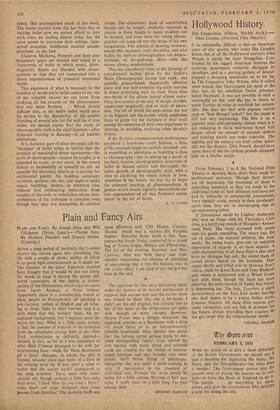Anna Pavlova.
THE twenty-fifth anniversary of the death of Anna Pavlova has been appropriately marked in print, in issues of recorded music, and in celebratorY performance. There can be few examples in theatrical history of artists whose influence has been so overwhelmingly good, and whose actual faults—small though they were—have been turned by circumstance into virtues. The good influences were that by her devotion to her craft she elevated the art of theatre dance to a level it does not seem ever to have reached before; and the means (money, organisation, trained personnel) were available for her to demonstrate her superb talent over the greater, part of the habitable globe in which theatres and audiences were to be found. A further effect was that by the example of her dancing and by her never-failing consideration for, and advice WI young people she impelled thousands, possibly tens of thousands, to take up the study of dancing seriously. Perhaps as many as half of all living great dancers and choreographers can truly claim that her per- formance, her advice, her shining example, were incentives in their own choice of theatrical career.
The faults, few but obvious, in her work were unimaginative choices of music, decor and theme for the greater part of her solos and ballets. The counter-balancing influence of the work of the Diaghilev Ballet has convinced the successors to both Pavlova and Diaghilev that these accessories of ballerinadom are to be as carefully chosen, arranged and manipulated as are the technique and expressiveness of the classical ballet mode—if what can be termed 'good ballet' is to result. The very magnitude of her interpretative talent overcame the inade- quacies of theme, the thinness of choreo- graphy, the cliché-laden plots, the saccharine
music, that accompanied much of her work. The lesson learned from this has been that in making ballet now we cannot afford to take such risks; no leading dancer today has the same power to overcome drab settings, unin- spired costumes, indifferent musical accom- paniment, as she had.
Ulanova, Markova, Fonteyn and their con- temporary peers are trained and tested in a framework of ballet in which music, d6cor, stagecraft, theme are blended with dance- patterns so that they are transmuted into a dance expressiveness of powerful emotional worth.
This awareness of what is necessary to the creation of worth-while ballet seems to me one of the valuable lessons we can learn from studying all the records of the phenomenon that was Anna Pavlova. . . . Which should indicate that, as the entire ballet world pays lip service to the desirability of the careful blending of several arts for the making of true ballet, we should expect that the study of choreographic craft is the chief function—after technical training in dancing—of all balletic institutions.
It is, however, part of what one must call the 'mystique' of ballet today to believe that the creation of meaningful dance movements—the craft of choreography—cannot be taught; it is expected to occur, or not occur, in the young dancer as incidentally or casually as, say, an appetite for chocolate éclairs or a passion for sentimental poetry. No budding composer, architect, sculptor, etc. etc., can begin to make music, buildings, statues, or whatever else, without first undergoing instruction_ from masters of his craft, or technicians whose com- prehension of the technique is complete even though they may not themselves be creative
artists. The elementary facts of constructing dances can be taught; academic exercises as precise as those taught to music students can be devised, and from them the young choreo- grapher can jump off into the deeps of his own imagination. Few schools of dancing, however, accept this necessary craft discipline, and trial ballets by embryo choreographers are demon- strations of hit-and-miss effect—with the misses always predominant.
This was abundantly clear at the showing of experimental ballets given by the Sadler's Wells Choreographic Group last week; one soundly proportioned, theatrically effective piece and one half-complete big-scale exercise in dance patterning were on view. More than two-thirds of the efforts lacked almost every- thing that matters in the way of design, rhytlim, elementary stagecraft, plot or style of execu- tion. For all of which the apprentices are not to be blamed, but the system which condemns them to grope for the elements of their craft among the memories of their own experience in dancing, in watching, analysing other people's .ballets.
If the Pavlova commemoration performance produced a handsome credit balance, a little of the proceeds might be usefully invested—not in something so ambitious as founding a class in choreography—but in setting up a panel of teachers, dancers, choreographers, historians of ballet to discuss calmly and, thoroughly the entire growth of choreographic craft, with a view to clarifying the whole notion of how, sometime in the future, we may try to begin the coherent teaching of choreographers. A gesture which would logically demonstrate our true appreciation of all that P.avlova's career meant to the art of ballet.
A. V. COTON



































 Previous page
Previous page